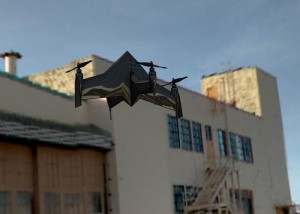 A new drone kid on the Kickstarter block may resemble Google’s Project Wing, but its inventor says it’s much more than a delivery drone – and much faster.
A new drone kid on the Kickstarter block may resemble Google’s Project Wing, but its inventor says it’s much more than a delivery drone – and much faster.
X PlusOne is a bi-wing hybrid drone prototype that can not only achieve hover stability but also has broken the 100 kmh barrier.
“The patent-pending design incorporates several key elements that lend themselves to speed and efficiency without compromising VTOL performance,” X PlusOne inventor J.D. Claridge told DRONELIFE. He added that the design achieves both by incorporating “a bi-wing lifting body configuration, lack of traditional flight control surfaces and novel refinements to the power plant/propeller configuration.”
While Claridge admits xCraft’s design resembles Google’s much-vaunted Project Wing delivery drone, he points out that it’s really an apples-vs.-oranges analogy.
“My honest first reaction [upon seeing Project Wing]? I was bummed! Although I was excited about what Google was doing with Project Wing, I thought they had beat us to the punch since their drone design looked similar to what we had been working on,” he said, adding that, when he investigated, he found no need to worry.
For one thing, Project Wing is specifically designed for autonomous delivery. Claridge says that while the X PlusOne could be adapted for delivery, it is a multi-use UAV. For another, the X PlusOne (which Claridge classifies as an intermediate-skill drone) includes a camera and can be used for highly acrobatic image capture.
“We really focused on making the craft stable and easy to fly so the operator can focus on framing their aerial shots rather than flying,” Claridge said, adding that “stability can be disabled to transform the X PlusOne into a mind-blowing aerobatic aircraft that will perform maneuvers that I used to only dream about.”
The X PlusOne uses a traditional 2.4 GHz 6 channel transmitter and Claridge hopes to add an autonomous option if xCraft reaches its Kickstarter goals.
“If we reach it, we’ll be able to make the X PlusOne fully capable of GPS-guided autonomous flight from takeoff to landing,” he said, adding that the “plan is to allow the use of a tablet or laptop computer to direct the [drone].” As currently designed, the X PlusOne is capable of self-stabilized and auto-level flight using onboard accelerometers and gyros.
“We will be adding a more powerful control board, GPS, baro and magnetometer sensors, as well as telemetry to allow fully autonomous flight,” Claridge said.
During initial test flights, the X PlusOne had a few problems with orientation loss. To combat that problem, the xCraft team incorporated a safety switch.
“With a flip of the transmitter switch, the X PlusOne will enter an auto-level hover from any flight attitude,” Claridge said.
“Once the craft is stabilized and hovering in place, the operator can re-orientate themselves and resume flying. With the autonomous option, we plan to incorporate position and altitude hold into this feature.”
The X PlusOne boasts a four-pound payload capability but recommends one pound. Options include a GoPro mount, Micro DV camera or 2-axis stabilized gimbal.
Support the X PlusOne Kickstarter campaign here.
Jason is a longstanding contributor to DroneLife with an avid interest in all things tech. He focuses on anti-drone technologies and the public safety sector; police, fire, and search and rescue.
Beginning his career as a journalist in 1996, Jason has since written and edited thousands of engaging news articles, blog posts, press releases and online content.
Email Jason
TWITTER:@JasonPReagan
Subscribe to DroneLife here.







Leave a Reply